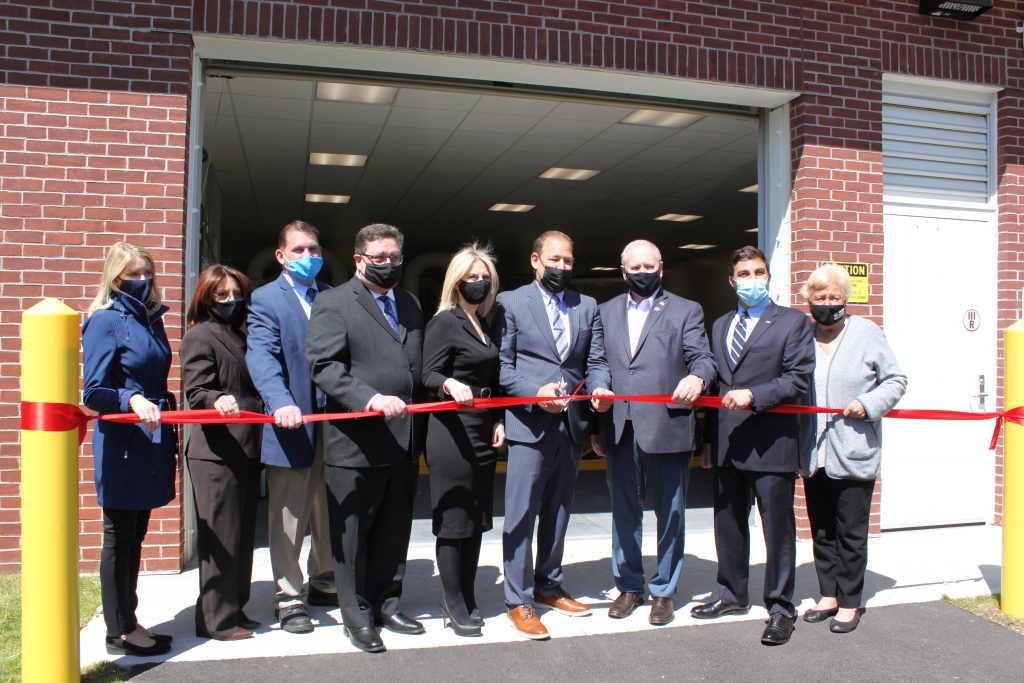New Treatment System Specifically Designed to Remove 1,4-Dioxane

Plainview, NY (April 27, 2021)—The Plainview Water District (PWD), along with area elected officials, hosted a ribbon-cutting ceremony to unveil the recently completed, state-of-the-art treatment facility that was specifically designed to remove the emerging contaminants 1,4-dioxane, PFOA and PFOS from the community’s drinking water. Plant 1, located at the District’s headquarters on Manetto Hill Road, is a $7.6 million facility capable of producing up to four million gallons of high-quality drinking water each and every day. The Plainview Water District has emerged as a leader in water treatment and has successfully put more Advanced Oxidation Process (AOP) systems in place than any other water supplier on Long Island.
“This is a significant moment for the Plainview-Old Bethpage community as it marks a major advancement in our abilities to provide our residents with the highest quality water for decades to come,” said PWD Chairman Marc Laykind. “Even before talks about regulating these new contaminants started, we were working on plans to construct this facility. Here we are, several years later with the project completed, serving water to our customers that is in compliance with some of the strictest regulations in the country. It is a proud day for the water district and our community.”
In August 2020, the New York State Health Department finalized regulations establishing maximum contaminant levels (MCLs) for emerging compounds 1,4-dioxane, PFOA and PFOS. The District started planning to build this treatment facility in 2018; at the same time the state started discussions about regulating these contaminants. Due to its proactive stance and sound financial planning, the District was able to fund this specific multi-million-dollar investment without impacting rates by using reserve accounts as well as receiving a $2.1 million grant the District was awarded from the state.
“We are proud to be one of the first water providers to have an operational AOP system and one of the few water suppliers impacted by emerging contaminants that did not need additional time to come into compliance,” said PWD Commissioner Amanda Field. “The Plainview Water District has put in a tremendous amount of time and effort to ensure that treatment was in place well before the regulations went into effect. Seeing the fruits of our teams’ labor is truly remarkable, especially when you consider what it means for our community.”
The treatment technology needed to remove 1,4-dioxane is called the Advanced Oxidation Process (AOP). It works by adding a small amount of an oxidant into the water—in this case hydrogen peroxide—that passes through an ultraviolet light reactor destroying the 1,4-dioxane molecules. From there, the water then travels through Granular Activated Carbon (GAC) filtration—industrial-sized carbon filters—so the remaining detections of the oxidant as well as other volatile organic compounds can be removed before water goes through the rest of the treatment and delivery process. This treatment duo, which is also effective at removing PFOA and PFOS, is the only method approved by state and local health departments to remove these synthetic compounds.
“This has been a herculean effort by our staff and our engineers to bring this facility from drawings into real life,” said PWD commissioner Andrew Bader. “This plant was built for longevity, meaning, over time, it will produce billions of gallons of the highest-quality drinking water for the Plainview-Old Bethpage community. By investing in our water, we are investing in our community for generations to come.”
For more information about emerging contaminants and the steps the District has taken thus far, please visit plainviewwater.org/resources/emerging-contaminants/. If you have questions or seek additional information, please call the District at 516-931-6469 or email info@plainviewwater.org. Residents are also encouraged to sign up to receive information by submitting their email address through the District’s homepage or following them on Facebook in order to stay up-to-date with District activities and initiatives.

